Adze to’i
Place: Tahiti & Society Islands
Category: Tools
wood, basalt, coconut fibre, Tahiti and the Society Islands, l. 56.5 cm (overall), l. 18.5 cm, w. 3.8 cm (blade), Inv. Oz 361
Humphrey No. 210: ‘Another [adze] affixed in a strong and ingenious manner to a handle of Wood with plaited Cordage. With these adzes the Natives of the Society Isles hollow out their Canoes, make planks, fell Trees etc.’
The material and form of this adze, which is in excellent condition, correspond largely to those of the specimen Oz 360. In contrast, however, it can clearly be seen that the hook-shaped end of the so-called ‘T shaft’ has been carved vertically, and that a tuft-like bundle of coconut fibres protruding from the lashing served as an interlining between string lashing and blade. Pieces of skin protruding from the edges of the cord lashing were used as an additional interlining between the stone blade and the wooden shaft. This interlining must have been of fish skin, as can be seen on a comparable adze in the Sparrman Collection in Stockholm, and which Söderström (1939: 28) pointed out as being exceptionally rare. Such an interlining has, however, also been documented for Tongareva; in this case, the skin of the maratea fish was used in addition to coconut leaves (kaka) (cf. Hiroa 1932: 186). Gundolf Krüger
Sources
Hiroa, Te Rangi, Ethnology of Tongareva, Bernice P Bishop Museum Bulletin, vol. 92, Honolulu, 1932.
Söderström, Jan, A. Sparrman’s Ethnographical Collection from James Cook’s 2nd Expedition (1772-75), New Series, Publication no. 6, The Ethnographical Museum of Sweden, Stockholm, 1939.

